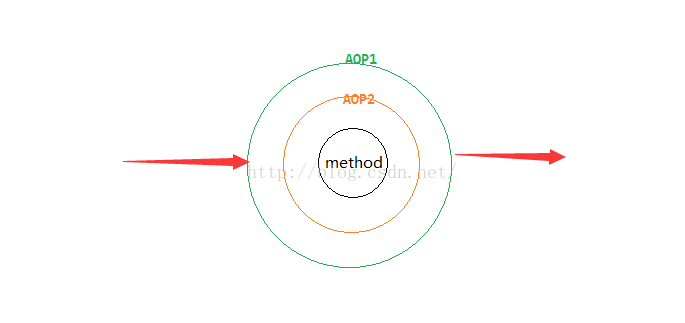Spring AOP执行先后顺序实例详解
2020-02-13 11:28
766 查看
这篇文章主要介绍了Spring AOP执行先后顺序实例详解,文中通过示例代码介绍的非常详细,对大家的学习或者工作具有一定的参考学习价值,需要的朋友可以参考下
众所周知,spring声明式事务是基于AOP实现的,那么,如果我们在同一个方法自定义多个AOP,我们如何指定他们的执行顺序呢?
网上很多答案都是指定order,order越小越是最先执行,这种也不能算是错,但有些片面。
配置AOP执行顺序的三种方式:
通过实现org.springframework.core.Ordered接口
@Component
@Aspect
@Slf4j
public class MessageQueueAopAspect1 implements Ordered{@Override
public int getOrder() {
// TODO Auto-generated method stub
return 2;
}
}
通过注解
@Component
@Aspect
@Slf4j
@Order(1)
public class MessageQueueAopAspect1{
...
}
通过配置文件配置
<aop:config expose-proxy="true"> <aop:aspect ref="aopBean" order="0"> <aop:pointcut id="testPointcut" expression="@annotation(xxx.xxx.xxx.annotation.xxx)"/> <aop:around pointcut-ref="testPointcut" method="doAround" /> </aop:aspect> </aop:config>
我们在同一个方法上加以下两个AOP,看看究竟。
@Component
@Aspect
@Slf4j
public class MessageQueueAopAspect1 implements Ordered{
@Resource(name="actionMessageProducer")
private IProducer<MessageQueueInfo> actionProducer;
@Pointcut("@annotation(com.xxx.annotation.MessageQueueRequire1)")
private void pointCutMethod() {
}
//声明前置通知
@Before("pointCutMethod()")
public void doBefore(JoinPoint point) {
log.info("MessageQueueAopAspect1:doBefore");
return;
}
//声明后置通知
@AfterReturning(pointcut = "pointCutMethod()", returning = "returnValue")
public void doAfterReturning(JoinPoint point,Object returnValue) {
log.info("MessageQueueAopAspect1:doAfterReturning");
}
//声明例外通知
@AfterThrowing(pointcut = "pointCutMethod()", throwing = "e")
public void doAfterThrowing(Exception e) {
log.info("MessageQueueAopAspect1:doAfterThrowing");
}
//声明最终通知
@After("pointCutMethod()")
public void doAfter() {
log.info("MessageQueueAopAspect1:doAfter");
}
//声明环绕通知
@Around("pointCutMethod()")
public Object doAround(ProceedingJoinPoint pjp) throws Throwable {
log.info("MessageQueueAopAspect1:doAround-1");
Object obj = pjp.proceed();
log.info("MessageQueueAopAspect1:doAround-2");
return obj;
}
@Override
public int getOrder() {
return 1001;
}
}
@Component
@Aspect
@Slf4j
public class MessageQueueAopAspect2 implements Ordered{
@Resource(name="actionMessageProducer")
private IProducer<MessageQueueInfo> actionProducer;
@Pointcut("@annotation(com.xxx.annotation.MessageQueueRequire2)")
private void pointCutMethod() {
}
//声明前置通知
@Before("pointCutMethod()")
public void doBefore(JoinPoint point) {
log.info("MessageQueueAopAspect2:doBefore");
return;
}
//声明后置通知
@AfterReturning(pointcut = "pointCutMethod()", returning = "returnValue")
public void doAfterReturning(JoinPoint point,Object returnValue) {
log.info("MessageQueueAopAspect2:doAfterReturning");
}
//声明例外通知
@AfterThrowing(pointcut = "pointCutMethod()", throwing = "e")
public void doAfterThrowing(Exception e) {
log.info("MessageQueueAopAspect2:doAfterThrowing");
}
//声明最终通知
@After("pointCutMethod()")
public void doAfter() {
log.info("MessageQueueAopAspect2:doAfter");
}
//声明环绕通知
@Around("pointCutMethod()")
public Object doAround(ProceedingJoinPoint pjp) throws Throwable {
log.info("MessageQueueAopAspect2:doAround-1");
Object obj = pjp.proceed();
log.info("MessageQueueAopAspect2:doAround-2");
return obj;
}
@Override
public int getOrder() {
return 1002;
}
}
@Transactional(propagation=Propagation.REQUIRES_NEW)
@MessageQueueRequire1
@MessageQueueRequire2
public PnrPaymentErrCode bidLoan(String id){
...
}
看看执行结果:

从上面的测试我们看到,确实是order越小越是最先执行,但更重要的是最先执行的最后结束。
这个不难理解,Spring AOP就是面向切面编程,什么是切面,画一个图来理解下:

由此得出:spring aop就是一个同心圆,要执行的方法为圆心,最外层的order最小。从最外层按照AOP1、AOP2的顺序依次执行doAround方法,doBefore方法。然后执行method方法,最后按照AOP2、AOP1的顺序依次执行doAfter、doAfterReturn方法。也就是说对多个AOP来说,先before的,一定后after。
如果我们要在同一个方法事务提交后执行自己的AOP,那么把事务的AOP order设置为2,自己的AOP order设置为1,然后在doAfterReturn里边处理自己的业务逻辑。
以上就是本文的全部内容,希望对大家的学习有所帮助
您可能感兴趣的文章:
相关文章推荐
- Java技术_基础技术(0003)_类执行顺序详解+实例(阿里面试题)+详细讲解+流程图
- android ontouch,onclick, longclick先后顺序详解
- spring学习笔记(10)@AspectJ研磨分析[3]增强织入顺序实例详解
- C/C++---printf/cout 从右至左压栈顺序实例详解
- C#数据结构之顺序表(SeqList)实例详解
- Asp.NET页面中事件加载的先后顺序详解
- DOM事件阶段以及事件捕获与事件冒泡先后执行顺序(图文详解)
- Java类继承关系中的初始化顺序实例详解
- DOM事件阶段以及事件捕获与事件冒泡先后执行顺序(图文详解)
- ORACLE 监听服务和实例服务有先后顺序?
- 实例详解JavaScript中setTimeout函数的执行顺序
- ORACLE 监听服务和实例服务有先后顺序?
- C语言实现静态顺序表的实例详解
- C/C++---printf/cout 从右至左压栈顺序实例详解
- 实例化一个对象(类加载)的执行顺序详解
- DOM事件阶段以及事件捕获与事件冒泡先后执行顺序(图文详解)
- C语言线性表的顺序表示与实现实例详解
- C语言中函数参数的入栈顺序详解及实例
- 关于c++构造函数、析构函数在全局实例(global)和在局部实例先后顺序
- UIViewController中各方法调用顺序及功能详解(1)
